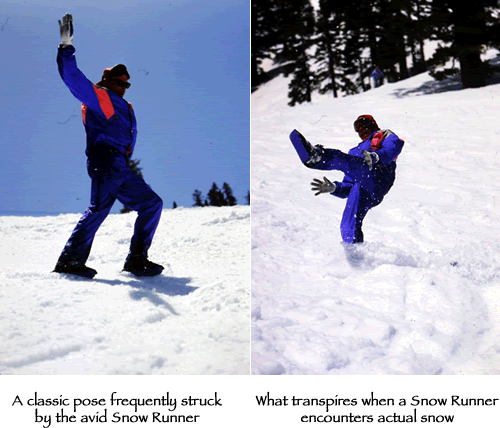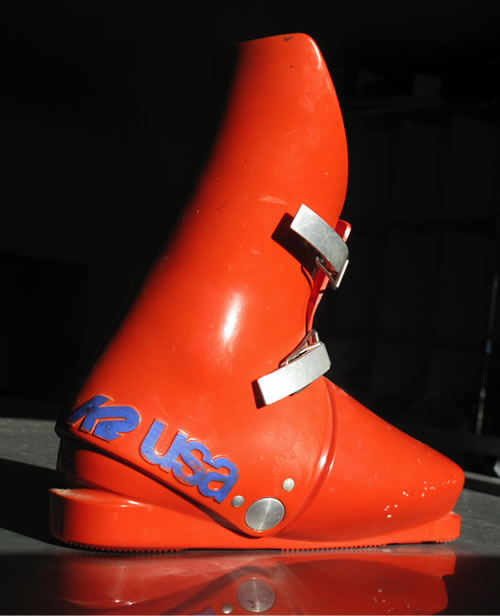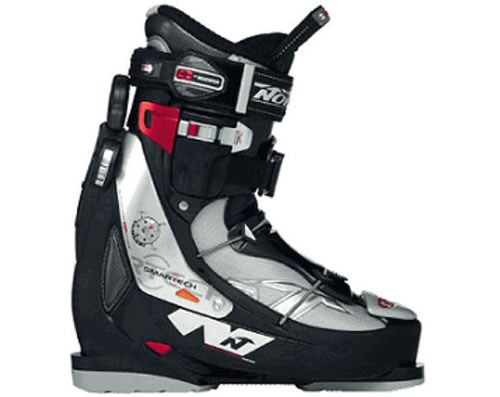It may seem mean-spirited to pick on dreadful alpine boot designs, until one remembers the pain and/or terror such boots inspired. Because mankind is a richly varied species, some skiers may vigorously protest the inclusion of one of their favorite pieces of footwear on this list, to which I can only reply, your angels must be particularly vigilant.
If you detect a tone that’s already veering towards snarky, your senses are operating correctly. Consider this newsletter to be the Joan Rivers Memorial edition.
To spare delicate sensibilities, we’ll avoid speaking ill of the living. Every boot on our list is out of production or, in a couple of cases, never made it into production. We’ve also trimmed a list that could have run to triple figures to twenty.
I confess I haven’t skied every last shoe on this list, but I have endured most of them and have the mental scars to prove it. There are certainly other, well-deserving candidates for inclusion in our exclusive club. We invite you to nominate your least favorite boots of all time on realskiers’ Facebook page.
Nava – The Nava was more than just a terrible boot; it included a horrid plate binding and a strut connecting the two wretched devices into one nefarious whole. As the boot had the foot-gripping power of a furry après-ski mukluk, the only elements assisting you downhill were the strut behind your knee– which, BTW, was unconnected to the release mechanism – and your thighs, which would be put to the greatest test of their lives.
Snow Runner – The Snow Runner makes our podium as no other boot before it embodied the innovative notion of eliminating the ski from skiing. As a sop to those unfamiliar with ski-less skiing, the savants at Dalbello who conceived the Snow Runner curved the front sole extension slightly upward, so it could now easily slide over any snow surface as long as it wasn’t more than a half-inch deep. Sled Dogs followed in the Snow Runners tracks, adding a few inches of boot sole to the rear, which solved everything.
Dachstein Clean & Light – If you’ve never heard of it, it’s probably because only a handful of men ever tried it and lived. This unique boot discarded every known means of containing the foot in the service of one, overriding, stroke-of-genius concept: the machine-washable inner boot. The single closure buckle that limply held the rear-entry spoiler in rough proximity to the collapsible front cuff didn’t provide enough tension to safely tilt the boot laterally. You needed to machine wash the liner frequently as you’d likely soil yourself during every terror-filled descent.
Caber Bio – It’s one thing to make an unskiable shoe; it’s another level of hubris to claim that you’re right and everyone else is wrong. Like every boot ever made, the Bio affirmed that it had finally solved the riddle of how to deliver comfort and control. Supposedly conceived by a renegade doctor who was the first to grasp how the foot needed to operate in a ski boot, the Bio allowed a special omni-range of motion that all but nullified the steering properties normally associated with the term, “boot.”
Olin T/1 – Touted to have “the performance of a 5-buckle boot,” the Olin T/1 skied more like a barge with a bum keel. Rarely has foot retention depended more on the power of prayer. The inner was made from slabs of undifferentiated foam; the only hope of adjustability lay in two knobs over the forefoot that lowered an internal plate into the instep. Two impressive meat hooks reached around the rear-entry spoiler but did little to stabilize rear support, or support of any other kind.
K2 Rear-Entry – Like the Olin T/1, K2’s mid-1970’s series of 3 rear-entry models were made from Adiprene™, a DuPont elastomer that deformed easily and transferred energy slooowly. The Homer Simpson “Doh!” Award goes to the designer who imagined that screws embedded in the sole of the boot could be easily adjusted to lift the foot ever upwards into the boot’s un-contoured cavern. Since there was no way to adjust the boots if the customer were standing in them, every futile stab at bootfitting involved more standing and sitting than a game of musical chairs.
Raichle RE Viva – The Golden Age of Rear-Entry, aka the ‘80’s, inspired many of the most insipid designs in modern history, many of which we have immortalized here. But while relatively few of the truly bad RE’s had much of a following, Raichle’s RE Viva sold by the truckload. At only $199, this single-buckle RE was affordable to many Americans, which was precisely the problem. The Viva had the support of an unlaced tennis shoe, skiing as if the hyper-mobile cuff were disconnected from the lower shell. Little wonder so many souls tried and gave up skiing during the RE era.
Hanson Prima – Hanson created the rear-entry category with the Prima, which is why it can’t be left off the list. Many of its imitators, and they were legion, were much worse, but the Prima had its own issues. The hot wax bladders meant to fill the voids between the non-descript injected liner and the sleek, futuristic shell were prone to rupture, which may be how Dr. Evil picked up the phrase, “hot, molten magma.” The first generation Hanson had no other way to adjust fit, flex or any other function but despite these demerits it inspired a rash of convenient-entry concepts, nearly all of them bad.
Nordica Smartech – In a word, hilarious. No other boot sold to the public looked more like a science project. Gaping cutouts reduced the shell to patches of PU riveted together in part by a diagonal metal swath that passed directly over the hinge rivet, eliminating any actual hinging. Exposed wires circumnavigated an overstuffed inner boot, connected to a handle mounted on the rear that allowed the skier to ratchet up tension much like a salad spinner. Honorable Mention medallion goes to the Syntech F8, Smartech’s wicked stepparent.
Rossignol Soft – For a few moments in the early 00’s, the boot world teetered on a fault line: were soft boots, which removed as much hard plastic as possible, about to become the Next Big Thing? Rossi staked out the high ground, with a polished product, an ahead-of-the-field launch and ownership of the best name, “Soft.” Only problems were control was compromised and comfort not all it was cracked up to be. Only a couple of me-too models were shown by other brands and within the span of one product cycle Soft boots were, mercifully, kaput.
Dynafit DTS – Dynafit 4-buckle boots were once easily identified by the all the hardware they’d glom onto the spine, but it was the internal cables that ran every which way through the rear-entry DTS that earned this model its plaque in the halls of infamy. The crossed-up wires could become so entangled that the hapless consumer had to be cut out of his shells, which had the distressing but perhaps beneficial side effect of murdering the boots.
Scott Ultralight – My own brief history with Scott boots was littered with casualties: cuffs fractured, latches broken, soles ripped off and one customer hospitalized. Except for the hospital part, this was a fairly typical customer experience with the first generation of Scott boots. Fitting involved rudimentary components that the bootfitter would assemble inside the featherweight shell, which I believe was made from the same material as Pringles. (Actually, it was ABS.)
Lange CFX – During most of the Rear-Entry Era, Lange remained steadfastly committed to four-buckle, overlap boots. Lange engineers thought rear-entry boots were the stupidest idea anyone ever conceived, so to prove it they made one of their own. To demonstrate the genre’s shortcomings, they made little effort to contain the foot, and when presenting the new models Lange marketers were quick to point out their many weaknesses. Needless to say, these babies were all but stillborn, although Lange later put some marketing muscle behind a few mid-entry models.
Kaufman Exo – If ever an alpine boot had a longer gestation period than the Kaufman Exo – without ever manufacturing a marketable boot – we’re not aware of it. The Exo sought to take the soft boot concept to the extreme, using the minimum amount of carbon fiber to hold a cushy walking boot, what we now call a snowboard boot and then called a Sorel, Kaufman’s signature product. As the years ticked by, the Exo remained in development limbo. A skiable prototype demonstrated that it was possible to steer a ski with it, and it was amusing to feel snow against the foot; amusing, however, isn’t the same as desirable.
Every “Air” boot – Pause for a moment to reflect on the probability that air is likely to provide a terrific means of holding the foot. (Compressed air could hold you, for sure, but a foot coma would shortly ensue.) If retaining the foot with pockets of air sounds like a magic trick, it is. Air bladders have lined the inner spaces of boots from Lowa, Koflach, Nordica, Head and Tecnica, just to name a few who once hung their hat on this dubious innovation. The wonderful thing about inflatable bladders is that they are palpable in the store, reinforcing the illusion that they’ll resist the foot’s tendency to roam around inside the shell once all is set in motion. Here’s a hint: if you’re filling a huge void between the skier and the shell, with air or foam or whatever, stop what you’re doing.
Tyrolia NTF 780 – During the late 80’s and early 90’s, a lot of brands had a case of Salomon envy; if a humble French binding company could successfully – make that wildly successfully – diversify into boots and skis, then why couldn’t they? The condition was particularly acute at Tyrolia, which battled Salomon for binding share supremacy in market after market worldwide. So perhaps it was inevitable that Tyrolia would make a line of lamentable skis with boots to match. Deploying a unique shell architecture that faintly resembled a Venus flytrap with buckles, the NTF 780 was richly embellished with adjustments that couldn’t overcome the sensory-deprivation-tank qualities of the sumptuously padded liners.
Henke Royal – Henke’s rush to produce a lightweight boot made from “expanded polyurethane” resulted in an inherent weakness in the closure straps, which invariably broke off. Problem was, the buckle business was part and parcel of the boot. When the brand’s all-in gamble went bust, so did the company. Henke’s swift descent from penthouse to flophouse alerted other brands to the dangers of injecting an entire, one-piece shell, leading to the multi-component boots we still use today.
Lange’s Leaking Liners – While we’re on the subject of fatal errors, Lange didn’t expect its mobile Flo contents would interact with new faux-leather liners, bursting through seams and covering consumers in viscous goo that, if they were lucky, sacrificed only their socks. Lange could have replaced the liners – at great but not cataclysmic cost -if it hadn’t so successfully glued them to the base of the shells. The removable liner is this fiasco’s eternal legacy.
Dolomite Secret Weapon – It’s a safe conjecture that no boot ever exceeded the up-to-the-knee height of the Dolomite Secret Weapon, although the Nordica Polaris, Tecnica Squadra and a handful of others were in the same league. Knee-high boots were miraculously comfortable on sensitive shins and were predicted to achieve widespread popularity that they might have attained had they not looked like props from the set of Camelot. All knee-highs could have found a hidden home inside today’s blousy pants – the Secret Weapon was secret because it could hide under warm-ups – but when exposed to the light of day they appeared, well, odd. They almost instantly plummeted to novelty status and were soon forgotten.
Salomon SX 70 – Let he who is without sin cast the first stone. Okay, so realskiers shouldn’t be tossing brickbats around, not when both Keelty and Hogen were on watch when the SX 70 (and women’s SX 60) were foisted upon an unsuspecting public. All successful boot lines decline from a relatively precise, race-like top model to a shapeless shoe for the masses. And so the SX 90 Equipe, boot enough (with some, ahem, modifications) for the likes of Marc Girardelli, stripped of all its top-end features, arrives at the dismal destination of the SX 70.
Keelty, the first, only and briefly tenured U.S. Marketing Director for Nava Systems (who almost uniquely learned to manage Navas), stands doubly chagrined, although the consequences thankfully were more limited than were those of the Salomon SX tsunami.
We conclude our riveting narrative with this vignette, torn from history’s unrecorded chapters:
Time: 1988
Location: Roof of the Hotel Meridien, Newport Beach CC
Event: US Ski Team fundraiser
Context: I’m dressed for tennis, on my way to the courts when I’m drafted to ski in a parallel slalom, conducted on the roof of the Meridien (swanky) parking garage (less so), on a bed of ice cubes normally destined to festoon daiquiris.
Plot Twist: Only equipment available is from the hotel’s (!) rental department. So I’m on nondescript rental slats and SX 70’s.
Second Plot Twist: I make it to the finals.
Deflating reality: I’m now racing head-to-head against Ken Read on a bed of ice cubes probably made from Perrier, only I’m on rental skis made from pixie dust. Wearing SX 70’s, which somehow convey the impression that they’re more nervous than I am.
Poignant conclusion: I’m plucky, but a plucky loser. Ken Read beats me. Turns out “talent” is a factor.
Moral: I blame the boots.





